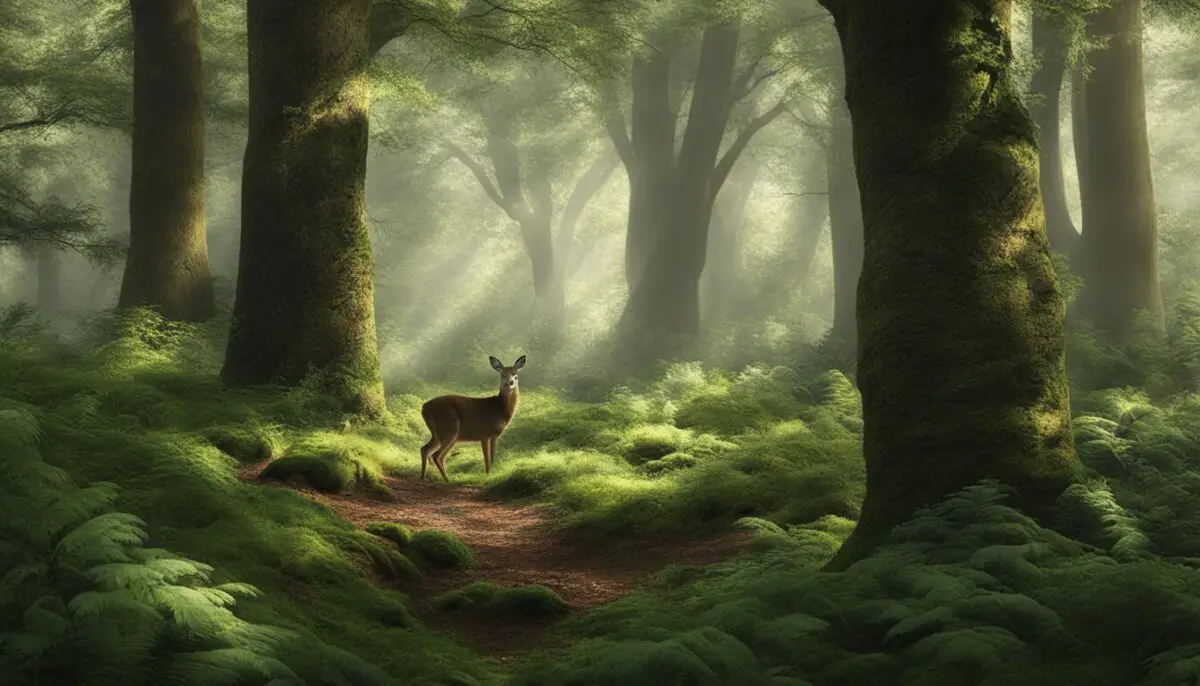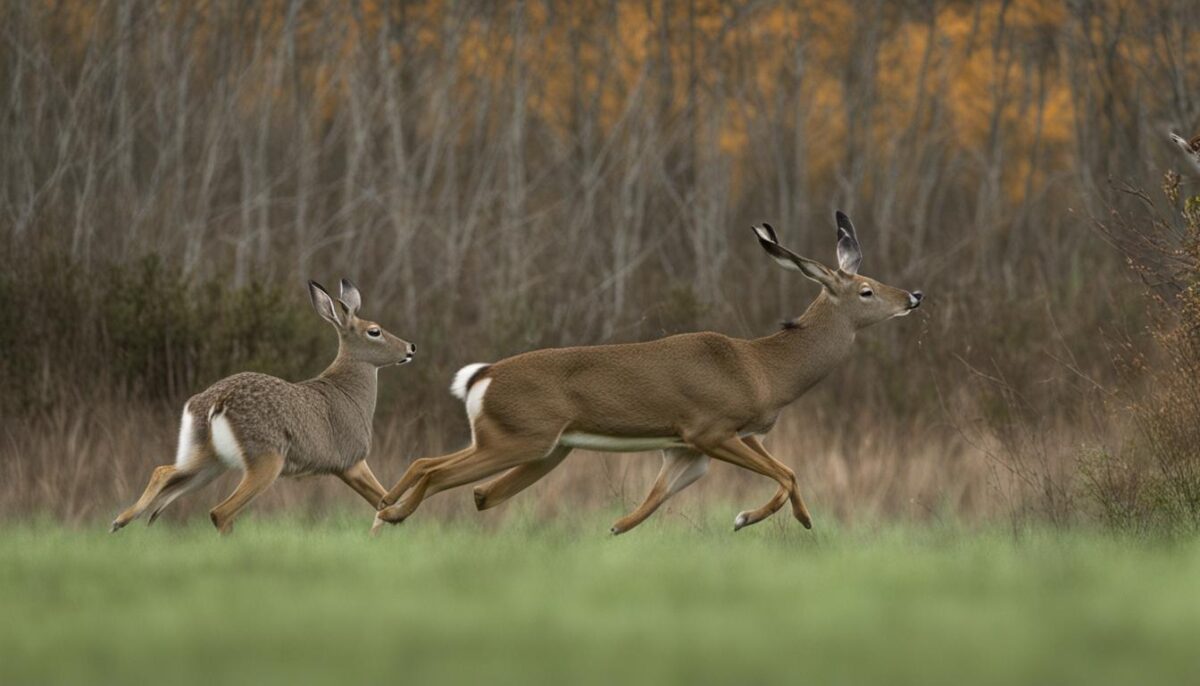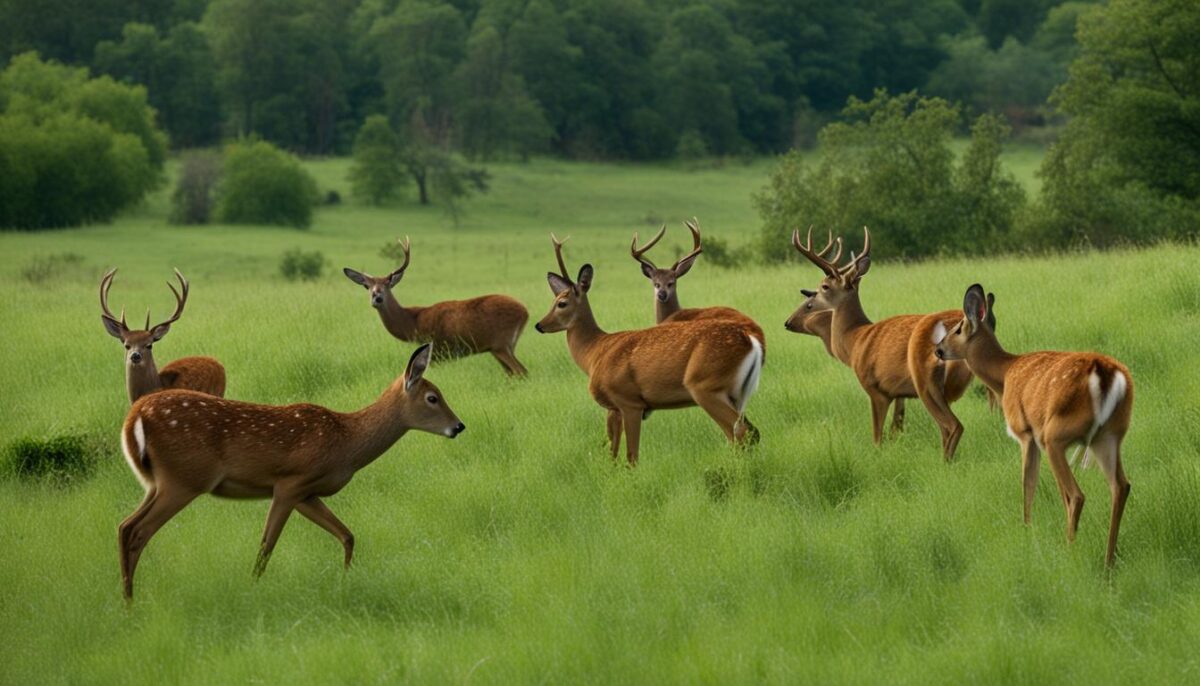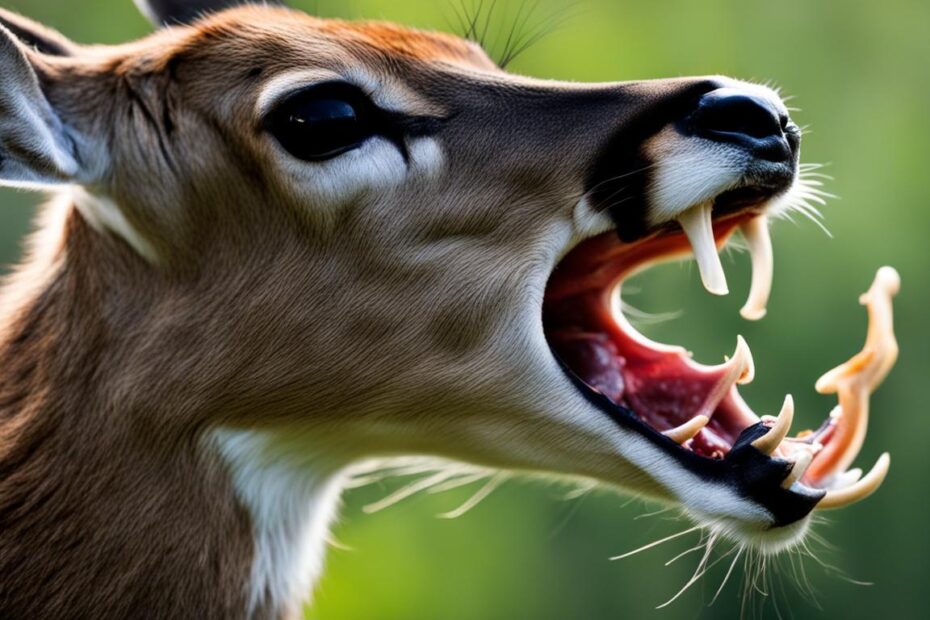Deer, typically classified as herbivores, have surprised researchers by exhibiting carnivorous behavior, including consuming rabbits and other small animals. This unexpected discovery challenges our understanding of deer eating habits and raises questions about their coexistence with rabbits in their natural habitats.
The traditional view of deer as strict herbivores has been disrupted by observations of them snatching songbird hatchlings, scavenging rabbit carcasses, and even consuming trapped birds. While deer primarily consume plant-based diets, these instances of carnivorous behavior suggest that they are opportunistic feeders, adapting their diet to include meat as a source of additional nutrients.
This interaction between deer and rabbits has ecological significance, highlighting a predator-prey relationship that was previously unrecognized. The consumption of rabbits by deer may be driven by the need for protein, fat, and minerals, especially during periods of antler growth. Understanding these complex dynamics is crucial for truly comprehending the intricacies of food chains and the interactions between different species in an ecosystem.
Key Takeaways:
- Deer have been observed consuming rabbits and other small animals, challenging their classification as strict herbivores.
- This carnivorous behavior suggests that deer are opportunistic feeders, adapting their diet to include meat for additional nutrients.
- The interaction between deer and rabbits has ecological significance, highlighting a previously unrecognized predator-prey relationship.
- Understanding the complexities of food chains and species interactions is crucial for understanding the dynamics of ecosystems.
- Further research is needed to fully comprehend the implications of deer predation for the coexistence of deer and rabbits in their natural habitats.
Unexpected Discoveries: Deer as Carnivores
Recent research has shed light on a surprising aspect of deer behavior – their ability to adopt a carnivorous diet. While deer are typically classified as herbivores and known to consume plant-based diets, observations have revealed instances where they engage in carnivorous behavior, particularly white-tailed deer. This unexpected discovery challenges the traditional view of deer as strict herbivores and raises intriguing questions about their feeding behavior and coexistence with other animals in their ecosystems.
Scientists have documented instances of white-tailed deer exhibiting carnivorous tendencies. They have been observed snatching vulnerable songbird hatchlings from nests, consuming trapped birds, and scavenging the carcasses of rabbits. These unexpected actions suggest that deer have the capacity to be opportunistic feeders and diversify their diet by including meat as a source of additional nutrients.
This newfound behavior poses interesting implications for the wildlife food chain and the coexistence of deer with other animals, particularly rabbits. While rabbits are typically herbivores themselves, the presence of deer as potential predators introduces a new dynamic to their relationship. How does the presence of carnivorous deer influence the rabbit population and their survival strategies? Are there changes in the dynamics of the wildlife food chain as a result? These questions remain open for further study.
“The unexpected carnivorous behavior of deer challenges our understanding of their feeding habits and interactions with other species in their ecosystems. It showcases the versatility and adaptability of these herbivorous animals.”
The coexistence of deer and rabbits in particular is worth exploring. In a traditional sense, rabbits may have relied on deer as herbivores with little predatory inclination. However, with the revelation of their carnivorous tendencies, the dynamics between these species becomes more complex. How do they interact in terms of competition for food resources? How does the presence of deer as potential predators impact the behavior and population dynamics of rabbits? These aspects of their coexistence warrant further investigation.
Deer Feeding Behavior: Opportunistic and Nutrient-Driven
The unexpected carnivorous behavior of deer points to their opportunistic feeding nature. While plant-based diets form the foundation of their nutrition, the additional intake of meat suggests a need for supplementary nutrients. It is possible that deer turn to meat as a source of calcium, proteins, and fat, especially during periods of high energy demands, such as antler growth.
According to researchers, this behavior may indicate that deer possess the flexibility to adapt their diet based on environmental conditions and nutrient availability. It emphasizes the importance of understanding the intricacies of their feeding behavior and the factors that influence it. The carnivorous tendencies exhibited by deer challenge conventional classifications and exemplify their ability to respond to fluctuating resource availability.

The Ecological Significance of Deer Predation
The carnivorous behavior of deer has broader ecological implications. It introduces the notion of a predator-prey relationship between deer and animals such as rabbits, which was previously unacknowledged. The consumption of rabbits and other small animals by deer strengthens the wildlife food chain, highlighting the complex interconnections between species.
This predation behavior suggests that deer serve as predators within their ecosystems, contributing to population regulation and influencing the dynamics of other animal populations. It underscores the importance of considering the role of deer as both herbivores and carnivores when assessing ecological relationships and ecosystem balance.
Further understanding the ecological significance of deer predation and their interactions with other species is crucial for informed wildlife management and conservation efforts. By comprehending the complex behavior of these seemingly herbivorous animals, we can gain deeper insights into the functioning of ecosystems and promote the preservation of biodiversity.
Ecological Significance of Deer Predation
The consumption of rabbits and other small animals by deer has profound ecological implications. It unveils a previously unrecognized predator-prey relationship and sheds light on the complex dynamics of food chains within ecosystems.
Deer, typically regarded as herbivores, may prey on rabbits as a way to supplement their diet with essential nutrients. This behavior becomes particularly apparent during periods of antler growth when deer require additional protein, fat, and minerals.
This interaction between deer and rabbits highlights the delicate balance of nature and emphasizes the importance of understanding the relationships between different species in an ecosystem. By exerting predation pressure on rabbits, deer play a vital role in regulating the population size of these small animals and shaping their distribution patterns.
Understanding the ecological significance of deer predation contributes to our knowledge of the intricate web of interactions that governs the natural world. It highlights not only the adaptability of deer as they diversify their diet but also the broader implications for the stability and functioning of ecosystems.
The following table provides a summary of the ecological effects of deer predation on rabbit populations:
| Ecological Effects of Deer Predation on Rabbits | Explanation |
|---|---|
| Regulation of Rabbit Population | Deer prey on rabbits, helping to control their numbers and prevent overpopulation. |
| Distribution Patterns | The presence of deer as predators influences the distribution patterns of rabbits, shaping their habitat preferences and range. |
| Impact on Vegetation | By reducing rabbit populations, deer predation indirectly affects the consumption of vegetation, potentially altering the composition and structure of plant communities. |
| Ecosystem Stability | The presence of predator-prey interactions, such as deer preying on rabbits, contributes to the overall stability and resilience of ecosystems. |
Through the ecological significance of deer predation, we gain a deeper understanding of the intricate connections that shape our natural world. By examining the interactions between deer and rabbits, we can paint a more complete picture of the complex networks that underpin our ecosystems.

Carnivorous Herbivores: A Widespread Phenomenon
It may come as a surprise that deer are not the only herbivores known to exhibit carnivorous behavior. Other animals such as cows, horses, and small antelopes have also been documented consuming meat. This phenomenon suggests that carnivorous tendencies among herbivorous animals are more common than previously believed.
The motivations behind these behaviors can vary. Nutritional deficiencies or the availability of alternative food sources are among the factors that may drive herbivores to consume meat. While herbivorous animals primarily rely on plant-based diets, their occasional forays into carnivorous habits could serve to supplement their nutrient intake or address specific dietary deficiencies.
Examples of Herbivorous Animals with Carnivorous Behaviors:
- Cows grazing on the carcasses of small animals
- Horses consuming mice or birds
- Small antelopes hunting insects or feeding on carrion
Researchers continue to explore why certain herbivorous animals engage in carnivorous behavior and how it impacts their overall diet and health. Understanding these habits is key to comprehending the intricacies of ecological relationships and the adaptability of animals in their respective environments.
| Herbivorous Animal | Carnivorous Behavior |
|---|---|
| Cows | Grazing on small animal carcasses |
| Horses | Consuming mice or birds |
| Small Antelopes | Hunting insects or feeding on carrion |

Case Study: The Deer’s Opportunistic Diet
Dr. Rachel Johnson, a wildlife biologist, describes the incident as an isolated occurrence and emphasizes that it should not be generalized to deer’s overall eating habits. She explains, “Deer are primarily herbivores, consuming vegetation such as grass, leaves, and buds. Instances of deer consuming meat, including rabbits, are rare and not representative of their typical diet.”
“Deer’s opportunistic behavior highlights their ability to adapt and survive in various environments. While they primarily rely on plant-based diets, their occasional consumption of meat suggests a flexibility in dietary choices.”
Further research is needed to fully understand the reasons behind such behavior and its ecological significance. The interaction between deer and rabbits remains an intriguing area of study, shedding light on the complex relationships within ecosystems.
| Species | Typical Diet | Occasional Carnivorous Behavior |
|---|---|---|
| Deer | Vegetation: grass, leaves, buds | Rare instances of consuming meat, including rabbits |
| Rabbits | Herbivorous: grass, plants, bark | N/A |
The table above compares the typical diets of deer and rabbits. While rabbits are strictly herbivorous, deer’s occasional carnivorous behavior challenges conventional understanding and suggests a more intricate relationship between these species.
Exploring Possible Explanations
Researchers have put forth several theories to explain the intriguing carnivorous behavior observed in deer. One hypothesis suggests that deer consume meat, including rabbits, to obtain additional nutrients such as calcium, proteins, and fat. This behavior could be driven by a nutritional need, particularly during antler growth. Deer are known to exhibit selective browsing behavior based on nutrient availability, and consuming meat may fulfill a specific dietary requirement.
Another possible explanation is that the presence of meat in the deer’s environment leads to occasional inclusion in their diet. When meat is readily available, deer may opportunistically engage in carnivorous behavior. This could occur when deer come across a rabbit carcass or during times of migration when they encounter bird hatchlings or trapped birds.
Understanding the factors that influence deer feeding behavior is crucial to unraveling the mystery behind their carnivorous tendencies. While deer are primarily herbivores, their occasional consumption of meat has ecological significance and can impact the predator-prey dynamics within ecosystems. Further studies are needed to delve deeper into the ecological consequences and underlying motivations behind this behavior.
| Possible Explanations |
|---|
| Deer consume meat for additional nutrients, such as calcium, proteins, and fat. |
| Deer opportunistically include meat in their diet due to the availability of meat in their environment. |
Key Points:
- Deer may consume meat for nutritional supplementation.
- The availability of meat in their environment can influence deer’s dietary choices.
- Further research is needed to understand the factors influencing deer feeding behavior and the ecological significance of their predation.
Conclusion
The surprising behavior of deer preying on rabbits challenges the traditional classification of herbivores and carnivores. It highlights the complexity of nature and the need for a nuanced understanding of predator-prey relationships and food chains. The coexistence of deer and rabbits in their natural habitats poses an intriguing ecological puzzle.
Further research is necessary to fully comprehend the ecological significance of deer predation and its implications for their coexistence. Understanding the factors that drive deer to consume rabbits and other small animals is crucial in determining the long-term impact on both species and their respective ecosystems.
By studying these interactions and their ecological consequences, scientists can gain valuable insights into the delicate balance of nature. This knowledge can inform conservation efforts, aiding in the preservation of biodiversity and promoting harmonious relationships between wildlife species.
FAQ
Do deer eat rabbits?
Yes, deer have been observed consuming rabbits and other small animals. While deer are primarily herbivores, instances of deer preying on rabbits suggest a more complex interaction between these species.
Why do deer eat rabbits if they are herbivores?
Deer may prey on rabbits to supplement their diet with protein, fat, and minerals, especially during periods of antler growth. This behavior highlights the complexity of food chains and the importance of understanding the interactions between different species in an ecosystem.
Is it common for herbivores to exhibit carnivorous behavior?
While surprising, it is not uncommon for herbivorous animals, such as deer, cows, horses, and small antelopes, to occasionally consume meat. The prevalence of this behavior suggests that it is more common than previously thought, but researchers are still exploring why some herbivores engage in this behavior and how it impacts their overall diet and health.
Is there evidence of deer preying on humans?
While there have been rare incidents of deer consuming human remains during studies on human decomposition in the wild, it is important to note that there is no evidence to suggest that deer pose a threat to humans or actively seek out human flesh as part of their diet.
Why do deer engage in carnivorous behavior?
Researchers have put forth several theories to explain why deer consume meat, including rabbits. One hypothesis suggests that deer may consume meat for the additional nutrients it provides, such as calcium, proteins, and fat. Another possibility is that the availability of meat in their environment leads them to occasionally include it in their diet. Further studies are needed to better understand the factors influencing deer feeding behavior.
What does the consumption of rabbits by deer mean for their coexistence?
The consumption of rabbits and other small animals by deer suggests a predator-prey relationship that was previously unrecognized. It challenges the traditional classification of herbivores and carnivores and highlights the complexity of nature. Further research is necessary to fully comprehend the ecological significance of deer predation and its implications for the coexistence of deer and rabbits in their natural habitats.


